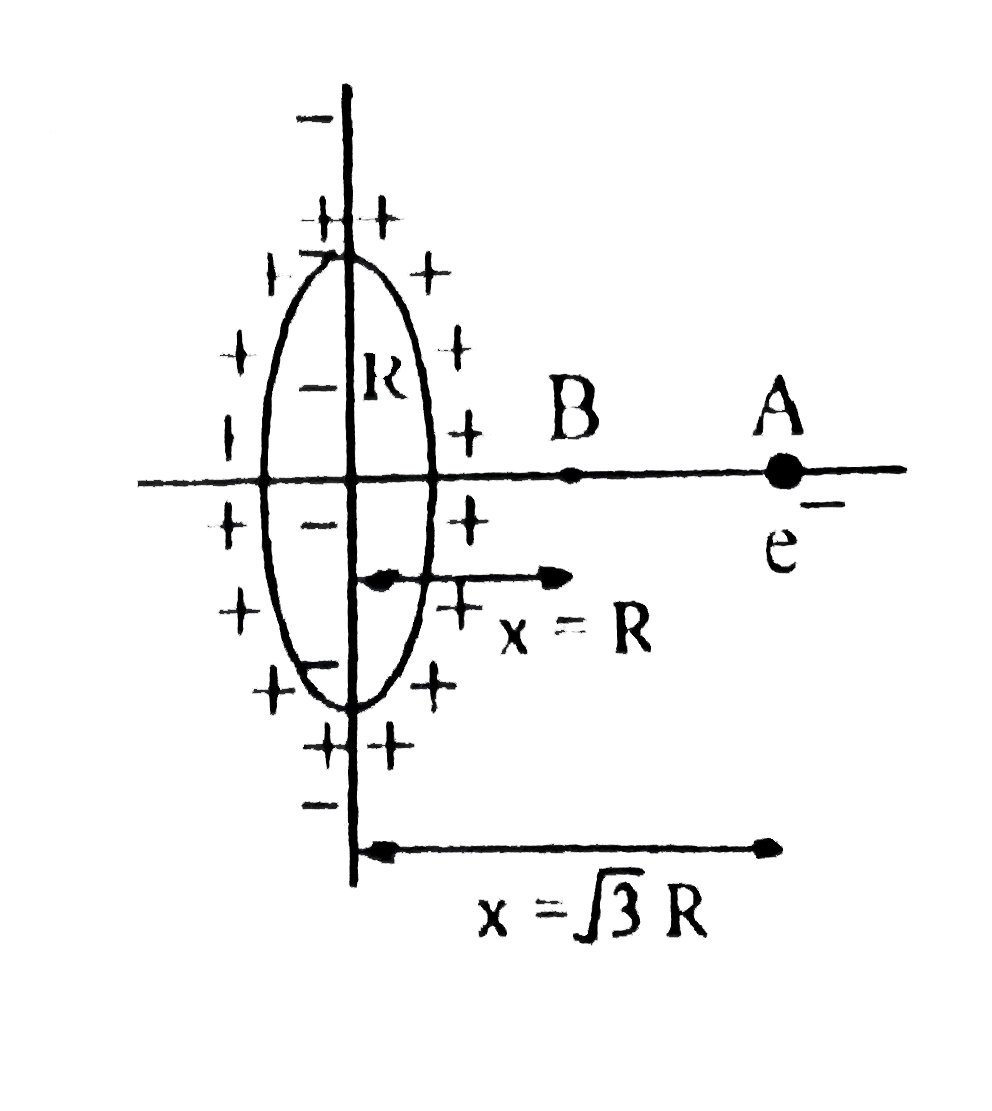There is a uniformly charged ring having radius R. An infinite line charge (charge per unit length lambda) is placed along a diameter of the ring (in gravity free space). Total charge on the ring Q=4√2λR. An electron of mass m is released from rest on the axis of the ring at a distance x=√3R from the centre.

The distance from centre of ring on the axis where the net force on the electron is zero.
2R
√2R
R
none of these
The correct Answer is:C
Electricfield E=−λ2πɛ0x+Q4πɛ0x(R2+x2)3/2 (considering right direction as positive)
=λ2πɛ0[−1x+x4√2R2(R2+x2)3/2]
=λ2πɛ0[−1x+2√2×R(R2+x2)3/2]
Initiallyx=√3R
E=λ2πɛ0R[−1√3+2√2√38]
λ2πɛ0R⎡⎢
⎢⎣−2√2+3√3(2√2)⎤⎥
⎥⎦=λ2πɛ0R(3−2√22√6)
a(acceleration)=(−e)(E)m=−eλπɛ0mR(3−2√24√6)
Sol(2) Force on electron is zero at point where E=0⇒x=R
Sol(3) Potential difference between two points
ΔV=−Edx
P.d. due to line charge between
x=R&x=√3R
VA−VB=−√(3)R∫R−λdx2πɛ0x=λπɛ0(ln34)
Potential difference due to ring between x=√3Randx=R
VA−VB=14πɛ0(4√2λR2R−4√2λR√2R)=−λπɛ0(1−1√2)
Net VA−VB=−λπɛ0[(1−1√2)−ln34]
Topper's Solved these Questions
- MASTER PRACTICE PROBLEMBook:BANSALChapter:MASTER PRACTICE PROBLEMExercise:Reasoning
Explore 75 Videos
- MASTER PRACTICE PROBLEMBook:BANSALChapter:MASTER PRACTICE PROBLEMExercise:Multiple objective
Explore 131 Videos
- MASTER PRACTICE PROBLEMBook:BANSALChapter:MASTER PRACTICE PROBLEMExercise:Additional topic
Explore 70 Videos
- FLUID MECHANICSBook:BANSALChapter:FLUID MECHANICSExercise:PYQS AIEEE
Explore 10 Videos
- SEMICONDUCTORSBook:BANSALChapter:SEMICONDUCTORSExercise:CBSE Question
Explore 32 Videos
Similar Questions
Statement-1: The numerical value (n)of a physical quantity is inversely proportional to size of unit (u) being used to measure it.
Statement-2:The magnitude of physical quantity does not change by changing the units.
View SolutionThe quantity// quantities that does //do not have mass in its// their dimentions (when we take standard 7 quantities as fundmental) is//are:
View SolutionThe manifestation of band structure in solids is due to
View SolutionA cylinder of height 20m is completely filled with water. The velocity of effux of water (∈ms−1) through a small hole on the side wall of the cylinder near its bottom is
View SolutionHow does the width of the depletion layer of a p-n junction diode change with decrease in reverse bias?
View SolutionA ring of radius R carries a uniformly distributed charge +Q. A point charge −q is placed on the axis of the ring at a distance 2R from the centre of the ring and released from rest. The particle executes a ismple harmonic motion along the axis of the ring.
View SolutionTwo identical coaxial rings each of radius R are separated by a distance of sqrt3R . They are uniformly charged with charges +Q and -Q respectively. The minimum kinetic energy with which a charged particle (charge +q ) should be projected from the centre of the negatively charged ring along the axis of the rings such that it reaches the centre of the positively charged ring is
View SolutionAn electric dipole is kept on the axis of a uniformly charged ring at distance d from the centre of the ring. The direction of the dipole moment is along the axis. The dipole moment is p , charge of the ring is Q & radius of the ring is R . The force on the dipole is
View SolutionAn unchanged conducting sphere of radius R is placed near a uniformly charge ring of radius R. Total charge on ring is Q. The centre of sphere lies on axis of ring and distance of centre of sphere from centre of ring is R
View SolutionSTATEMENT 1: When a negative charge -q is released at a distance R from the centre and along the axis of a uniformly and positvely charged fixed ring of radius R, the negative charge does oscillation but not SHM. STATEMENT 2: The force on negative charge is always towards the centre of the ring but it is not proportional to the displacement from the centre of the ring.
View SolutionThere is a uniformly charged ring having radius R. An infinite line charge (charge per unit length lambda) is placed along a diameter of the ring (in gravity free space). Total charge on the ring Q=4√2λR. An electron of mass m is released from rest on the axis of the ring at a distance x=√3R from the centre.

Magnitude of initial acceleration of the electron.
View SolutionThere is a uniformly charged ring having radius R. An infinite line charge (charge per unit length lambda) is placed along a diameter of the ring (in gravity free space). Total charge on the ring Q=4√2λR. An electron of mass m is released from rest on the axis of the ring at a distance x=√3R from the centre.

Potential difference between points A(x=√3R) and B(x=R)i.e.(VA−VB) is
View SolutionA short dipole is placed on the axis of a uniformly charged ring (total charge -Q, radius R) at a distance R√2 from centre of ring as shown in figure. Find the Force on the dipole due to that ring

View SolutionA system consists of a him charged wire ring of radius R and a very uniformly charged thread oriented along the axis of the ring with one of its ends coinciding with the centre of the ring. The total charge of the ring is equal to q. The charge of the thread (per unit length) is equal to λ. Find the interaction force between the ring and the thread.

View SolutionA ring of radius R is with a uniformly distributed charge on it. A charge q is now placed at the centre of the ring. Find the increment in tension in the ring.
View Solution

